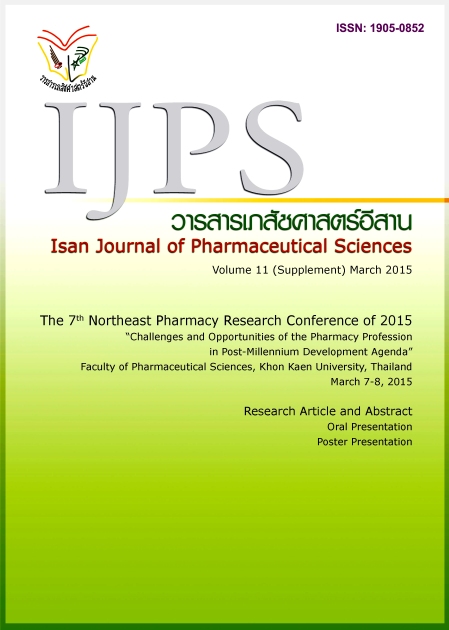Effects of gelling and sweetening agents on characteristics of Maprang crude extract’s (Bouea macrophylla Griff) jelly product
Main Article Content
Abstract
Introduction: Maprang (Bouea macrophylla Griff) is a common fruit in Anacardiaceae family which has high
nutritional values. Common chemical compositions in Maprang are carotenoid, and phenolic compound which show effects on antioxidant and anti-cancer properties. It was therefore the aim of this research to study effects of gelling agents and sweeteners on characteristics of Maprangs’ jelly. Materials and Method: Three different solvents, namely, water, 50% ethanol and 95% ethanol were used to extract the Maprang. The extraction which contains high content of total carotenoid, phenolic, and % yield was carried out to prepare a jelly product. The Maprang jelly products were formulated by varying 2 types of gelling agents: gelatin and pectin, and sweeteners: sucrose and sucralose. Furthermore, chemical and physical properties of the formulations were tested. Results: 95%Ethanol was chosen as an extraction solvent because it provided the highest total carotenoids and phenolic compounds which were 4.64±0.23 % and 17.40±0.38%, respectively. By using 2 types of gelling agents and sweeteners, 12 formulations were obtained. Overall, the average pH of the product was 3.7. Results obtained from a Texture analyzer showed that the product using 14% gelatin and sucrose as sweetener had high values of firmness, Cohesiveness and chewiness. Moreover, 10 and 12% gelatin together with sucrose and sucralose revealed better the highest properties on springiness, whereas that of 10% gelatin and sucralose in the product had low lowest firmness, chewiness and cohesiveness compared to other formulations. Conclusion: According to the results, by using gelatin in the formulation, the firmness and springiness of the product were better than using pectin. Furthermore, the firmness of the product might be affected by the type of sweeteners. The texture of product was softer when using artificial sweetener in comparison to natural sucrose.
Article Details
In the case that some parts are used by others The author must Confirm that obtaining permission to use some of the original authors. And must attach evidence That the permission has been included
References
Chaleansuk, F.,The cultivation and propagation Maprang sweet -gooseberry. Bangkok: Publishers Petkaled ct, 1994.
Holm, K., et al. Sweetness and texture perceptions in structured gelatin gels with embedded sugar rich domains. Food Hydrocolloids 23 (2009) 2388–2393.
Laura, L., DeMar, Gregore, R., Ziegler. Texture and structure of gelatin/pectin-based gummy confection. Food Hydrocolloids15 (2001) 643–653.
Maisuthisakul, P., Sutthajit, M., Pongsawatmanit, R. Assessment of phenolic content and free radical-scavenging capacity of some Thai indigenous plants. Food Chemistry;100(2007): 409–418.
Nguyen Phuoc Minh. Various factors affecting to the production of Maprang (Thanh Tra) jam. International Journal of Multidisciplinary Research and Development2014; 1(5): 127-131.
Pacheco-Hernández MDL, et al. Chemical studies of Anthocyanins. Food Chemistry 2009; 113: 859–871.
Rinlapass Pukjinda. Formulation of health food from white kidney bean extract in the form of jelly. Nakhonpathom: Mahidol university 2012.
Supawadee Daodee, et al. Health product development from Bouea macrophylla Griffith and Antidesma velutinosum Blume: Their quality control and the study on memory deficit and depression. Khon Kaen: Khon Kaen University, 2014.
Vararat Chiving.The study of natural extracts on hyaluronidase inhibition. Khon Kaen: Khon Kaen University, 2013.
Mepanya Vilasinee. The complete study on the development of gummy jelly tamarind products. Phetchabun. : Rajabhat Phetchabun University, 2008.

